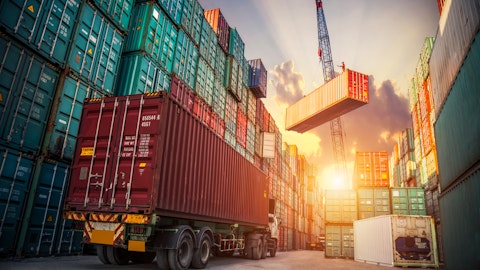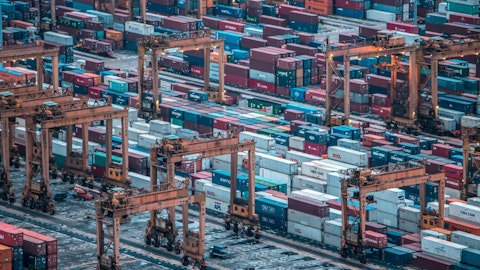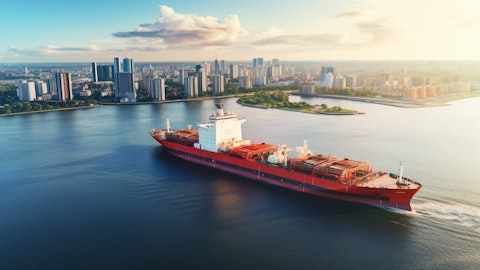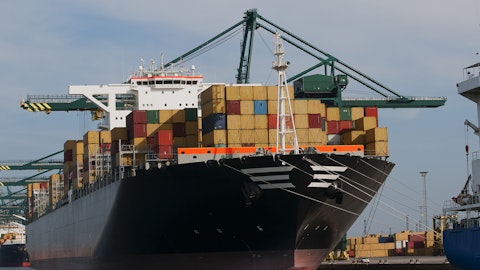Kirby Corporation (NYSE:KEX) Q4 2023 Earnings Call Transcript February 1, 2024
Kirby Corporation beats earnings expectations. Reported EPS is $1.04, expectations were $1.03. Kirby Corporation isn’t one of the 30 most popular stocks among hedge funds at the end of the third quarter (see the details here).
Operator: Good morning and welcome to the Kirby Corporation 2023 Fourth Quarter Earnings Conference Call. [Operator Instructions] Please note, this event is being recorded. I would now like to turn the conference over to Mr. Kurt Niemietz, Kirby’s VP of Investor Relations and Treasurer. Please go ahead.
Kurt Niemietz: Good morning and thank you for joining the Kirby Corporation 2023 fourth quarter earnings call. With me today are David Grzebinski, Kirby’s President and Chief Executive Officer, and Raj Kumar, Kirby’s Executive Vice President and Chief Financial Officer. The slide presentation for today’s conference call, as well as the earnings release, which was issued earlier today, can be found on our website. During this conference call, we may refer to certain non-GAAP or adjusted financial measures. Reconciliations of the non-GAAP financial measures to the most directly comparable GAAP financial measures are included in our earnings press release and are also available on our website in the Investor Relations section under Financials.
As a reminder, statements contained in this conference call with respect to the future are forward-looking statements. These statements reflect management’s reasonable judgment with respect to future events. Forward-looking statements involve risks and uncertainties, and our actual results could differ materially from those anticipated as a result of various factors. A list of these risk factors can be found in Kirby’s latest Form 10-K filing, and in our other filings made with the SEC from time to time. With that I will now turn the call over to David.
David Grzebinski: Thank you, Kurt, and good morning, everyone. Earlier today, we announced fourth-quarter revenue of $799 million and earnings per share of $1.04. This compares to 2022 fourth-quarter revenue of $730 million and earnings per share of $0.62. During the fourth quarter, continued strong fundamentals in both our businesses resulted in significant year-over-year growth in our revenue and earnings, and Marine Transportation pricing on spot and term contracts benefited from strong demand and limited availability of barges, while the onset of winter weather conditions proved to be a headwind to our efficiency in the quarter. Distribution and Services delivered higher revenues sequentially, but margins were down slightly from the third quarter as a result of lower demand in our Power Rental business and typical seasonal impact.
We ended the year on a good note and we anticipate strong growth in 2024. In Inland Marine, we continued to experience strong demand and high barge utilization, with our barge utilization rates in the low 90% range. Spot market prices continued to push higher and we were up in the low to mid-single-digits sequentially, and in mid-teens year-over-year. Pricing increases on term contract renewals were up year-over-year on average in the high-single-digits during the quarter. While the efficiency of our operations was challenged during the quarter, with delay in days up 86% sequentially, strong pricing and utilization mostly offset this, allowing for Inland Marine margins to remain flat sequentially, with operating margins remaining in the high-teens on average.
In our Coastal Marine business, we saw consistent customer demand during the fourth quarter that helped maintain barge utilization in the low to mid-90% range. Overall, Coastal Marine revenues were up 4% sequentially, as improved spot and term contract pricing more than offset planned maintenance and ballast water treatment installations, which reduced equipment availability. As a result, the Coastal business was able to finish the year with operating margins in the low-single-digit for the quarter. In Distribution and Services, demand in the fourth quarter remained steady throughout much of the segment, marked by a sequential increase in revenues, increases in new orders and steady backlog. In Oil and Gas, revenues and operating income were up sequentially and year-over-year, as solid execution on our backlog and deliveries were partially offset by lingering supply chain delays.
In Commercial and Industrial, while revenues were up sequentially, the seasonal falloff in our Power Rentals business led to a sequential decline in operating income. Despite supply chain issues and seasonal weakness, the business segment, overall, concluded the year very strong. Overall, segment revenues were up 13% year-over-year and operating margins were in the high-single-digits. In summary, our fourth quarter results reflected on growing strength in market conditions for both segments. Despite the temporary headwinds of seasonal winter weather in the quarter, the Inland market is strong and rates continue to push higher, helping to offset lingering inflation. While our Coastal revenue was challenged near-term by planned shipyards, industrywide supply and demand dynamics remain very favorable, our utilization is good, and we are realizing healthy rate increases.
Steady demand in Distribution and Services is contributing to further growth in the segment, and while supply chain bottlenecks are expected, the outlook for the market is stable. I’ll talk more about our 2024 outlook later, but first, I’ll turn the call over to Raj to discuss the fourth-quarter segment results and balance sheet in more detail.
Raj Kumar: Thank you, David, and good morning, everyone. In the fourth quarter of 2023, Marine Transportation segment revenues were $453 million, and operating income was $68 million, with an operating margin of 15%. Compared to the fourth quarter of 2022, total Marine revenues increased by $30 million or 7%, and operating income increased $21 million or 46%. Increased pricing and utilization in the Inland market were partially offset by weather-related inefficiencies in Coastal shipyards. Compared to the third quarter of 2023, total Marine revenues, Inland and Coastal together, increased 5%, while operating income increased by 7%. Now looking at the Inland business in more detail, the Inland business contributed approximately 82% of segment revenue.
Average barge utilization was in the low-90% range for the quarter. Long-term Inland Marine Transportation contracts or those contracts with a term of one year or longer, contributed approximately 60% of revenue, with 62% from time charters and 38% from contracts of affreightment. Tight market conditions contributed to spot market rates increasing sequentially in the low to mid-single-digits and in the mid-teens range year-over-year. Term contracts that renewed during the fourth quarter were, on average, up in the high-single-digits compared to the prior year. Compared to the fourth quarter of 2022, inland revenues increased by 11%, primarily due to higher term and spot contract pricing. Inland revenues were up 6% compared to the third quarter of 2023, due to higher pricing and the reopening of the Illinois River locks.
While Inland operating margins remained, on average, in the high-teens, we did exit at 20% in the final month of the quarter. Now moving to the Coastal business. Coastal revenues decreased 7% year-over-year and were up 4% sequentially, as downtime from planned shipyards was partially offset by higher contract pricing. Overall, Coastal had low-single-digit operating margins, as improved pricing was partially offset by increased shipyard base. The Coastal business represented 18% of revenues for the Marine Transportation segment. Average Coastal barge utilization was in the mid-90% range, which was in line with the fourth quarter of 2022. During the quarter, the percentage of Coastal revenue under term contracts was approximately 95%, of which approximately 94% were time charters.
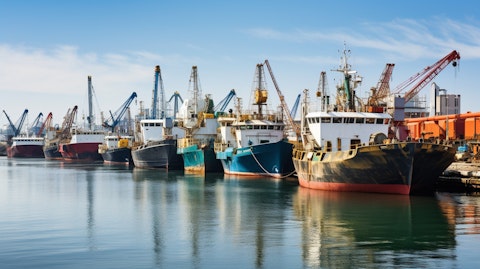
Average spot market rates were up in the mid-single-digits sequentially and in the mid-30% range year-over-year, and prices on term contract renewals were up in the 20% range year-over-year. With respect to our tank barge fleet for both the Inland and Coastal businesses, we have provided a reconciliation of the changes in the fourth quarter, as well as projections for 2024. This is included in our earnings call presentation posted on our website. At the end of the fourth quarter, the Inland’s fleet had 1,076 barges, representing 23.7 million barrels of capacity. On a net basis, we currently expect to end 2024 with a total of 1,078 Inland barges, representing 23.8 million barrels of capacity, driven by a modest number of additions in the year.
Now, I’ll review the performance of the Distribution and Services segment. Revenues for the fourth quarter of 2023 were $347 million, with operating income of $29 million and an operating margin of around 8%. Compared to the fourth quarter of 2022, the Distribution and Services segment saw revenues increase by $39.2 million or $13%, with operating income increasing by $11.6 million or $68%. When compared to the third quarter of 2023, revenues increased by $12 million or 3%, and operating income decreased by $4.5 million or 14%, with the decline in margins related to product mix. On the Commercial and Industrial markets, strong activity contributed to a 24% year-over-year, and 5% sequential increase in revenues, with improved demand for equipment parts and service in our marine repair and on-highway businesses.
Power generation was also up year-over-year. Overall, the Commercial and Industrial business represented approximately 64% of segment revenue, and had an operating margin in the mid to high-single-digits in the fourth quarter. In the Oil and Gas markets, revenues were down 3% year-over-year and up 2% sequentially, as solid execution on our backlog was partially offset by lingering supply chain delays. While we saw slowing trends in our conventional remanufacturing business, we experienced continued favorable trends in new orders and backlog, driven by our e-frac units and associated power generation equipment. Overall, Oil and Gas represented approximately 36% of segment revenue in the fourth quarter and had operating margins in the low-double-digits.
Now I’ll turn to the balance sheet. As of December 31st, 2023, we had $33 million of cash, with total debt of around $1 billion. During the quarter, we decreased our debt balances by $51 million, and our debt-to-cap ratio improved to 24.2%. We achieved cash flow from operating activities of $216 million for the quarter. We used cash flow and cash on hand to fund $127 million of capital expenditure or CapEx, of which $56 million was related to maintenance of equipment and the remainder was directed to growth CapEx in marine and e-frac. We continued to return capital to shareholders in the quarter and repurchased $52 million of stock at an average price of $77.08. As of December 31st, we had total available liquidity of approximately $491 million.
For 2024, we expect to generate cash flow from operations of $600 million to $700 million on higher revenues and EBITDA. We still see supply chain constraints posing some headwinds to managing working capital in the near-term. Having said that, we expect to unwind most of this working capital as orders shipped, as 2024 progresses and beyond. With respect to CapEx, we expect capital spending to range between $290 million and $330 million for the year. Approximately, $190 million to $240 million is associated with marine maintenance capital and improvements to existing Inland and Coastal marine equipment, including the remaining ballast water treatment system on some Coastal vessels and some facility improvements. Up to approximately $90 million is associated with growth capital spending in both of our businesses.
The net result should provide approximately $300 million of free cash flow for the year. We are committed to a balanced capital allocation approach and we’ll use this cash flow to opportunistically return capital to shareholders and continue to pursue long-term value creating niche investment and acquisition opportunities. I will now turn the call back to David to discuss the remainder of our outlook for 2024.
David Grzebinski: Thank you, Raj. We had a good quarter in both our businesses, despite some temporary headwinds. Refinery activity remains at high levels, our barge utilization is strong in both Inland and Coastal, and rates are steadily increasing. While we expect typical seasonal weather conditions to post some near-term headwinds in the first quarter and some high shipyard activity in our Coastal business, our outlook in the Marine segment remains strong for the full year. In Distribution and Services, despite supply chain constraints that we’ve discussed, demand for our products and services is good and we continue to receive new orders. Overall, we expect our businesses to deliver improved financial results in 2024. While all of this is encouraging, we are mindful of challenges related to a slowing global economy and additional economic weakness due to interest rates.
However, even with these uncertainties, we remain very positive and expect to drive strong earnings and strong cash flow from operations going forward. In Inland Marine, our 2024 outlook anticipates positive market dynamics with tight conditions due to limited new barge construction in the industry and many units going in for maintenance, combined with steady customer demand. With these market conditions, we expect our barge utilization rates to be in the low to mid-90% range throughout the year. Overall, Inland revenues are expected to grow in the mid to high-single-digit range on a full-year basis. Normal seasonal winter weather has started and is expected to be a headwind to revenues and margins in the first quarter as usual. With respect to operating margins, we expect to gradually improve during the year, with the first quarter being the lowest, and averaging around 20% for the full year, what will be a 300-basis point to 400-basis point improvement from the 2023 average.
In Coastal, market conditions have tightened considerably and supply and demand are balanced across the industry fleet. Strong customer demand is expected throughout the year, with our barge utilization in the low to mid-90% range. With major shipyards and ballast water treatment installations concluding in the first half of the year, revenues for the full year are expected to increase in the high-single to low-double-digit range when compared to 2023. Coastal operating margins are expected to be in the mid to high-single-digit range on a full-year basis, with the first quarter the lowest due to weather and shipyards. In the Distribution and Services segment, despite the uncertainty from volatile commodity prices, we expect to see incremental demand for OEM products, parts and services within the segment.
In Commercial and Industrial, strong demand for power generation and stable marine repair is expected to help drive full-year revenue growth in the high-single-digit to low-double-digit percent range. In Oil and Gas, our manufacturing backlog is expected to provide stable levels of activity through most of 2024, but will be somewhat offset by lower activity levels in the oilfield market. We anticipate extended lead times in the near-term to continue contributing to volatile deliveries with respect to the schedule of new products in 2024. Overall, the company expects segment revenues to be flat to slightly down on a full-year basis, with operating margins in the mid to high-single-digits but slightly lower than year-over-year due to mix. To conclude, we ended 2023 in a position of strength in both of our segments.
In Marine Transportation, barge utilization and customer demand remained strong, and rates continued to increase. In D&S, demand for our products and services remained strong and we continued to receive new orders in manufacturing. Overall, we anticipate our businesses to deliver 30% to 40% earnings growth in 2024. Key risks putting us at the lower end of that range would be the impact of a recession, a potential recession, or lingering inflation. While achieving the higher end of this range would be driven by stronger-than-expected chemical markets for Marine, and stronger than expected oil and gas markets in D&S. As we look long-term, we remain confident in the strength of our core businesses and our long-term strategy. Our Marine businesses are in the early innings of a multiyear up cycle and demand remains solid in D&S.
We intend to continue capitalizing on strong market fundamentals and driving value for our shareholders. Operator, this concludes our prepared remarks. We are now ready to take questions.
See also 15 Best Low Cost Stocks To Buy Under $75 and 11 Best Wine Stocks to Buy Now.
Q&A Session
Follow Kirby Corp (NYSE:KEX)
Follow Kirby Corp (NYSE:KEX)
Operator: [Operator Instructions] Our first question will be coming from Jack Atkins of Stephens. Your line is open.
Jack Atkins: Okay, great. Good morning, guys. Thanks for taking my questions.
David Grzebinski: Yes, good morning, Jack.
Jack Atkins: So David, I guess I’d like to, maybe if I could start with the CapEx guidance for a second, the $90 million I think in growth CapEx, can you kind of give us a little more color how that’s split between the Coast – excuse me, the Marine versus the Distribution businesses? And I guess if I look at the 39, if I’m reading this right, 39 new – I guess, how many barges are you planning on adding in 2024? I’m just trying to get that correct, as we think about next year. Are you building barges for 2024 in Inland?
David Grzebinski: No, what happened Jack is, we stepped into a competitor’s shipyard contract. They were, they were building some barges in some boats, they needed to not do that and we were able to step in and get a good deal with the shipyard. So those boats and barges, it’s basically two boats with about thrusting units that go with those, and then four barges. So we stepped into those that contract for them. It was kind of underway and the competitor couldn’t.
Jack Atkins: I got it. Oh, okay.
David Grzebinski: So we stepped in to – in it and it’s a good price. We were happy with it. Do we want building? No. New construction doesn’t make sense now. We were able to get a decent price on these and so we stepped into it. So that’s part of that growth CapEx and then we’re doing some things in C&I for KDS, it’s helping a little bit, but the biggest part of our CapEx, as is maintenance CapEx. We’ve talked about the maintenance bubble, it’s real. It’s real for the industry, it’s real for us. So our CapEx is still pretty elevated with the maintenance side of things.
Jack Atkins: Okay. No, that makes total sense. And thank you for clarifying that. And then I guess maybe just to that last point, I guess as you think about new builds in 2024 for the industry relative to, maybe anticipated retirements, can you walk us through that? And then, I know that a lot of the industry is going to be down for maintenance on the inland side in 2024, how much of your fleet do you think will be out for maintenance relative to your normal maintenance schedule in 2024?
David Grzebinski: Yes, it’s significant. It’s – in any given day, we’ll have 80 barges out, and I think for the industry, this is going to be a big year, it could be on the order of – well, I know it’s north of 600 and maybe as high as 1,000 for this year. So it’s a big number. I actually think this is positive for a number of reasons. One, it helps tight up utility, but more importantly, people are busy maintaining their fleet. They’re going to put their cash to that instead of going in to build new. It doesn’t make sense to build new. So it – , I think it actually helps the whole supply picture quite a bit, but it is a – it’s a known bubble and, the good news is our customers understand that. They’re sophisticated, they get it, they know what’s going on.
And inflation’s not helping this either, as you might imagine. Shipyards used to be, Jack, they’d run three shifts. Three shifts. Now a number of them can only crew two shifts and, shipyard costs have gone up, steel costs are going up, labor costs are very high. So all that’s factoring into keeping that supply in check, and I think that continues through ’25 to be honest. Yes.
Jack Atkins: And just on that first part of the question, would you think about new builds for the industry relative to retirements, would you expect net capacity attrition in ’24?
David Grzebinski: Absolutely. I think, what we’ve heard, there’s only about 20 barges, maybe 25 on dock for 2024. It’s, I would imagine – don’t have good data on retirements, but I could imagine, you bring something into the shipyard and you see it’s going to cost you a heck of a lot, you just soon retire it if it’s only got, five, five years left of its life. So we should see attrition of, my guess is 50 to 150 barges this year, so we should have a net decline this year in supply.
Jack Atkins: Okay, that’s really encouraging. Thanks for the time, David.
David Grzebinski: Hi, thanks, Jack.
Operator: And our next question will come from Ben Nolan of Stifel. Your line’s open, Ben.
Ben Nolan: Thank you. Hi David, Raj. Good numbers. So my first question is on the D&S side, specifically on the industrial side, it seems like that business has just really grown well over the last number of years, and as I’m looking forward and trying to, sort out how sticky that is, I’m just curious, if you could maybe talk to, on the industrial side, how you think of that with respect to whether it’s cyclical or maybe structural, and you’ve changed your business mix and that’s just resulted in more growth or have you captured share? How are you thinking about that industrial side of the business?
David Grzebinski: Yes. No, thanks, thanks for the question, Ben. Look, on the C&I side, there’s really three parts to it. There’s, on-highway and marine repair, and then there is power generation. So I’d say the first two, marine repair and on-highway really are going to move with the economy, right? We see a little pullback on-highway trucking space, you saw one of the truckers go bankrupt last year. We have seen a little pullback, that’s in our guidance to – for 2024. On marine, marine repair, we do both commercial marine and pleasure craft. With it being an election year, we’re seeing a little pullback in pleasure craft, but commercial marine repair is pretty strong, as you would expect, as you hear us talk about maintaining our vessels.
And then – but the real secular growth story is in power generation. I think it’s pretty obvious, everybody needs power 24/7 now. Every business, runs using computing power. I think AI and machine learning’s only adding to that demand. So we’re seeing secular growth in our – on our power generation side. As you know, we provide backup power to places like the New York Stock Exchange, JP Morgan and others, as well as retail environments like Walmart, Costco, Target and the like, as well rentals too, we rent power out. So, it’s – we’re seeing a lot of growth there. We manufacture some of that equipment. So it’s – it helps the manufacturing as well as the distribution side and that’s more of a secular growth story.
Ben Nolan: Okay. So, all in, if you were just to sort of take a high level approach to it, does it feel like the business is less cyclical than it used to be two or three years ago as a function of that power business?
